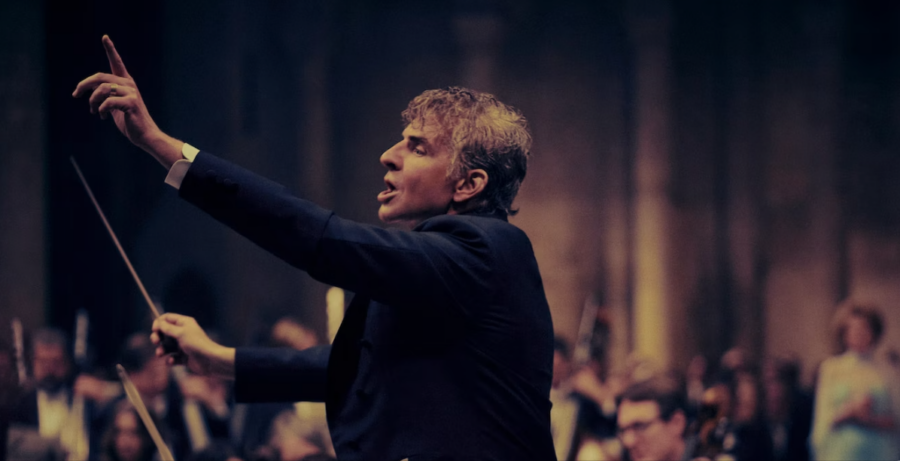Review of Maestro
Bradley Cooper’s sophomore film Maestro has generated much excitement and controversy since the announcement of its production. Produced by legendary filmmakers Martin Scorsese and Steven Spielberg coupled with a star-studded cast, the film was anticipated to be an even more exceptional addition to Cooper’s filmography than A Star is Born.
Following the life of extraordinary composer and conductor Leonard Bernstein and his relationship with theatrical actress Felicia Montealegre, Maestro takes us on a non-linear, highly emotional, intensely melodic journey through the lives of these two disparate artists and dissects their relation to each other.
Cooper himself takes on the role of Bernstein which was met with controversy due to the choice to wear a prosthetic nose which he proclaimed would help him better emulate Bernstein.
While some saw this decision as antisemitic, Bernstein’s eldest daughter Jamie who is played in the film by Maya Hawke, released a statement, along with her siblings, defending the incorporation of the prosthetic.
“Bradley Cooper included the three of us along every step of his amazing journey as he made his film about our father,” Jamie, Nina, and Alexander Bernstein told Vanity Fair. They added, “ It breaks our hearts to see any misrepresentations or misunderstandings of his efforts.”
Carey Mulligan who plays Costa Rican actress Felicia Montealegre has similarly commented on the film’s unique approach to telling its story and how it subverts the typical biopic structure. She told Vogue, “It’s a movie about a marriage — a very complicated marriage.”
She also noted how Bernstein and Montealegre’s relationship was a pinnacle of the film and essential to be explored. Mulligan added, “Their connection was profound…They lit each other up. You can hear it: There are tapes of them trading anecdotes and it’s like they’re dancing.”
Both Cooper and Mulligan extensively researched the complexity and intimacy of this relationship. Cooper’s confidence in Mulligan’s potential to perform was never fleeting but he was transparent in how demanding it would be for the actress asking her, “Will you go down this road where we’re basically going to bare our souls to each other?”
In the end, both actors’ performances bring unrelenting life to the legacy of both Bernstein and Montealegre. From their meeting to falling in love, to their more volatile moments, the musicality contained in their untamed presence fascinates audiences and seamlessly entwines itself with the structure of the film.
The perspective that the film’s central theme fixates on marriage and the complicated nature of celebrity marriages, however, is entirely subjective. With a loose plot and disorienting time jumps Maestro balances an array of thematic threads that find themselves lost in the convoluted web of Bernstein’s escapades.
The film feels as if it doesn’t have a complete foundational purpose. Bernstein’s and Montealegre’s marriage is definitely examined but so is Bernstein’s sexuality, infidelity, success, and family.
There are also abrupt breaks in the narrative to allow the music to really shine, including an awe-inducing scene of Bernstein conducting an orchestra in a cathedral performing Mahler’s Second Symphony. The scene is lengthy but never tiresome and only elucidates the dedication and mastery of his craft.

When the scene comes to a crescendo, it makes for a heart-stopping moment as you can feel the music in your chest and in your very soul. When the concert concludes some audience members may feel a slight ring in their ears, emulating how one may feel after leaving an actual concert.
The cathedral concert is just one example. The sound in this film is nothing short of phenomenal. The way Bernstein’s various scores are weaved into the film including the “Jet Song” from his most famous musical West Side Story, not only serves as a remembrance of his discography but is essential to how the film progresses.
As Mulligan described Bernstein’s and Montealegre’s interview tapes as if they were dancing, the film sees Bernstein dance his way through his life, relationships, and career. The scenes presented in black and white and in color also signify a haunting contrast between the highest and lowest moments Bernstein faces.
The choice to incorporate both black and white and color in the film might seem reminiscent of the aesthetically stylistic but contemptuous biopic Blonde, which like Maestro, was also distributed by Netflix. While these films feel paralleled in how they look at times, Maestro uses its artistic techniques to enhance the scope of the story.
The increasing use of black and white and color in historical biopics naturally creates discourse around why the choice was made and while Maestro’s story can feel poorly paced and over-indulgent at times, there is something to be said about the way the color affects the film.
The film starts with a vibrancy of color as an aged Bernstein sits before interviewers and laments over the loss of Felicia while solemnly playing his piano. We’re then thrust into the past, detailing in black and white, Bernstein’s impromptu first conduction at Carnegie Hall in place of conductor Bruno Walter.
As the film roars on, the pattern of black and white and color usage becomes clearer as it seems that the black and white moments are meant to evoke the energy of novelty while the scenes in color are meant to represent the effects of reality.
Many of the moments that portray pinnacles of Bernstein’s life from his first concert to meeting Felicia are done in black in white while the implications of those events reveal themselves in color such as Lenny and Felicia’s most eruptive argument.
These shifts in colors also demonstrate a shift in tone that doesn’t entirely align with the prospect that black and white is showing the warmer parts of Bernstein’s life and color is showing the darker.
A striking shot of Felicia standing backstage in the center of Lenny’s shadow while he’s conducting is portrayed in black and white, suggesting the new feeling of isolation in their marriage. This scene also signals what’s to come, unnerving and enticing the audience.
Even the aforementioned concert scene which would seem to represent one of the most profound moments in Bernstein’s career sees the conductor draining himself and giving all that he has in him to this performance.
It is apparent throughout the film, despite its jumbled storytelling, that each actor, like Bernstein throughout his career, is giving all that they can to ensure these characters appear authentic and accurately resemble their real-life counterparts.
Cooper’s passion coupled with his attention both in front and behind the camera does not go unnoticed. Even when the script falters and the story seems to lose its footing, it’s undeniable that a massive amount of effort and love was put into this project. It’s only fitting that a film about a man who gave his life to music receives such a detailed treatment.

